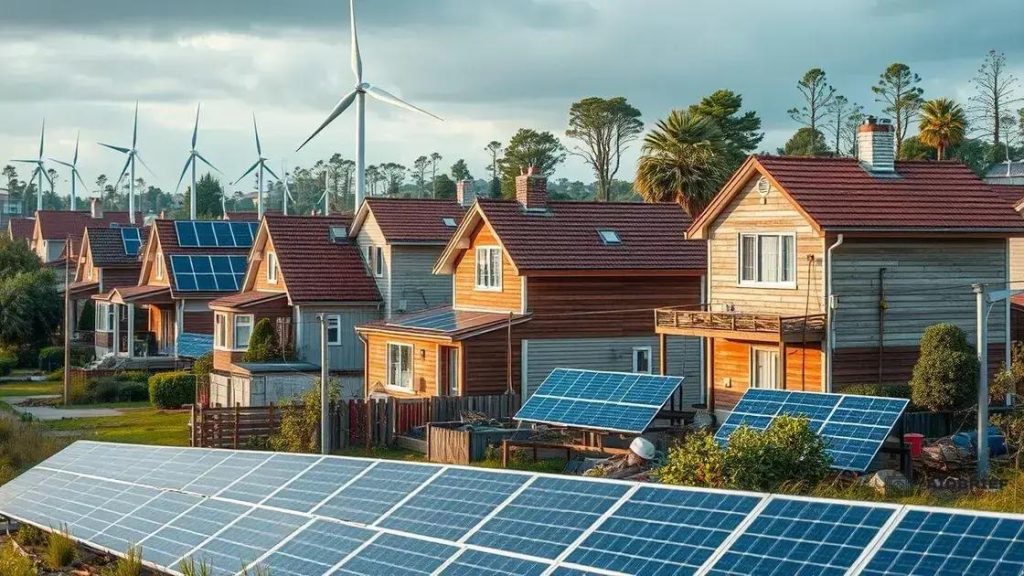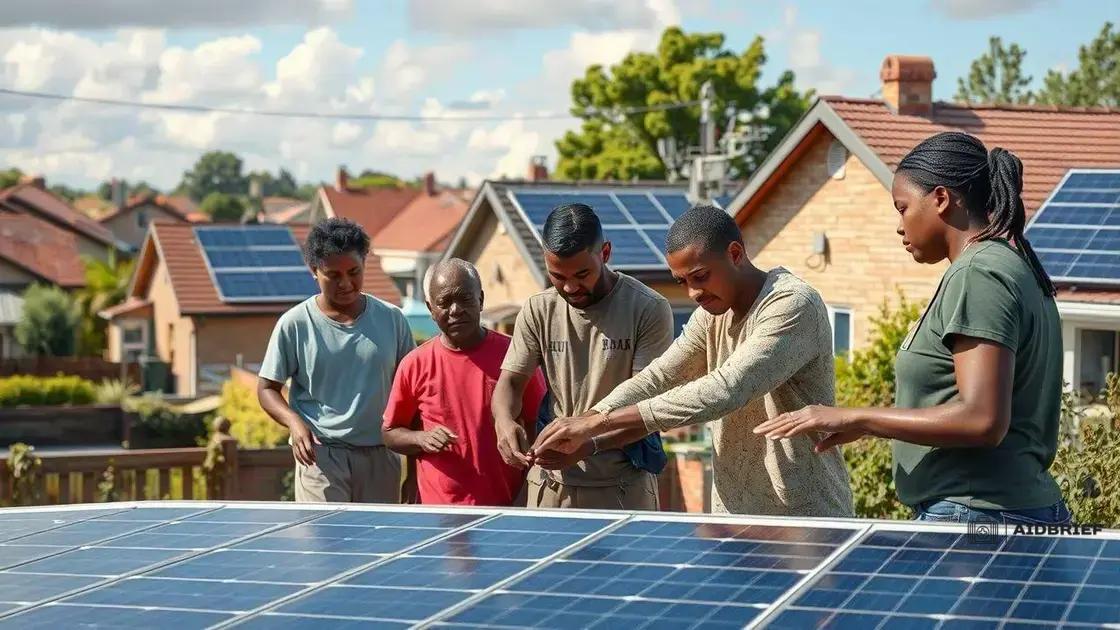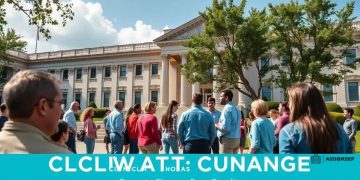Renewable energy aid projects: a lifeline for recovery zones

Renewable energy aid projects in post-storm recovery zones focus on integrating sustainable solutions like smart grids and energy storage, enhancing community resilience and reducing reliance on traditional energy sources.
Renewable energy aid projects in post-storm recovery zones are vital in helping communities rebuild and thrive. Have you considered how these initiatives can change lives while promoting sustainability? Let’s dive in.
Understanding renewable energy aid projects
Renewable energy aid projects play a crucial role in helping communities bounce back after disasters. By focusing on sustainable solutions, these projects ensure that energy needs are met without harming the environment. But what exactly do these projects entail?
Key Components of Renewable Energy Aid Projects
Understanding the essential elements of these projects is vital for their implementation. They often include:
- Community involvement: Engaging local populations ensures that projects meet specific energy needs.
- Technology transfer: Sharing knowledge and tools allows communities to sustain their energy solutions.
- Funding and support: Adequate funding is necessary to initiate and maintain projects over time.
- Partnerships: Collaborations with governmental and non-governmental organizations can amplify project impact.
These components work together to create efficient and effective energy solutions. Moreover, they contribute to long-term recovery and resilience.
Another key aspect is the type of renewable energy utilized. Projects may leverage solar, wind, or hydropower sources, depending on local conditions. For instance, solar panels can be deployed rapidly in sun-rich areas, while wind turbines may serve regions with consistent wind patterns. This adaptability is crucial in post-storm environments.
As communities rebuild, opting for renewable energy not only meets immediate needs but also fosters sustainability. The transition to green energy reflects a commitment to environmental health, which is especially important in areas vulnerable to future storms.
Renewable energy aid projects also prioritize education. Teaching community members about the technologies and systems in use empowers them to take ownership of their energy resources. Education helps generate enthusiasm and responsibility towards maintaining these systems.
Successful Implementation Examples
Globally, many examples illustrate how renewable energy aid projects have succeeded in post-disaster scenarios. Each project is tailored to local contexts and needs, yet they share common traits that make them successful:
- Immediate action: Projects that start quickly often prevent further energy crises.
- Community feedback: Listening to the needs of locals improves project effectiveness.
- Long-term vision: It’s not just about rebuilding, but also about planning for future resilience.
This comprehensive understanding of renewable energy aid projects reveals their potential impact in recovery zones. By focusing on sustainability and local needs, these initiatives can lead to lasting benefits for vulnerable communities.
The impact of storms on energy infrastructure
Storms have a significant impact on energy infrastructure, leading to widespread outages and disruptions in service. Understanding these effects is essential for building a more resilient energy system.
Physical Damage to Infrastructure
Severe storms can cause physical damage to power lines, substations, and other critical components of the energy grid. High winds and flooding often lead to:
- Downed power lines: These can result in immediate blackouts across large areas.
- Damaged transformers: Repairing or replacing these can take considerable time, worsening outages.
- Flooded substations: Water damage can cripple energy distribution and requires extensive repairs.
These disruptions highlight the vulnerabilities within our energy systems. When storms strike, the consequences ripple through communities, affecting homes and businesses alike.
The economic impact can be severe. When energy infrastructure fails, it does not just stop electricity from flowing. It also halts businesses, disrupts daily life, and increases costs for repairs and recovery efforts.
Long-Term Consequences
Moreover, the long-term consequences of these storms may lead to a need for upgrades in energy systems. As climate change increases the frequency and intensity of storms, it becomes essential to rethink how we build and maintain our energy infrastructure. Investments in stronger, more resilient designs should be prioritized.
Transitioning to renewable energy sources can also play a role in mitigation. Renewable resources tend to have lower maintenance costs and can be distributed across various locations, reducing the risk of widespread outages. By diversifying energy sources, communities can improve resilience and recovery times.
Furthermore, regular assessments of infrastructure can help identify weaknesses. Implementing advanced technologies, such as smart grids, can enhance monitoring and response capabilities. With these innovations, cities can better withstand the challenges posed by storms.
Successful case studies of recovery initiatives

Successful case studies of recovery initiatives illustrate how communities can effectively utilize renewable energy in the wake of disasters. These examples serve as models for future efforts, highlighting key strategies that lead to positive outcomes.
Case Study: Hurricane Sandy Recovery
In 2012, Hurricane Sandy struck the East Coast, causing extensive damage to energy infrastructure. In response, several communities adopted renewable energy solutions. One noteworthy project involved the deployment of solar-powered microgrids. This technology allowed neighborhoods to generate their own electricity even during grid outages.
Residents actively participated in the planning process, ensuring that these systems met local needs. The result was a more resilient energy supply that contributed to faster recovery.
Case Study: Puerto Rico’s Post-Hurricane Maria Response
After Hurricane Maria in 2017, Puerto Rico faced significant challenges in energy recovery. Many areas remained without power for months. In response, grassroots organizations implemented various renewable energy projects. These initiatives included the installation of solar panels in schools and community centers.
This approach not only provided immediate energy relief but also educated residents about clean energy practices. The projects showcased how renewable energy can facilitate both recovery and sustainability.
Case Study: The City of New Orleans
New Orleans, recovering from Hurricane Katrina, invested heavily in green energy initiatives. The city launched programs that encouraged homeowners to install energy-efficient systems and solar panels. These efforts improved residents’ resilience against future storms while reducing energy costs.
The involvement of local governments and businesses was key to the success of these programs. Collaboration fostered a sense of community, leading to widespread participation and enhanced energy security.
These case studies demonstrate the potential of renewable energy aid projects in recovery initiatives. By focusing on community involvement and innovative technologies, they pave the way for resilient energy solutions that benefit both people and the environment.
Challenges in implementing renewable energy solutions
Implementing renewable energy solutions presents a range of challenges that can hinder progress. Despite their benefits, various factors can complicate the adoption of these technologies in recovery zones.
Financial Barriers
One significant challenge is the initial cost of renewable energy technologies. Many communities face budget constraints that make it difficult to invest in solar panels, winds turbines, or energy storage systems. Securing funding is crucial for overcoming these financial barriers.
- High upfront costs: The installation of renewable systems often requires substantial investments.
- Lack of incentives: Without government incentives or subsidies, many communities struggle to afford these technologies.
- Market fluctuations: Changes in the economy can impact funding availability and project viability.
These financial challenges can delay or prevent the implementation of renewable energy projects, limiting their potential benefits for communities.
Technical Issues
Technical challenges also play a vital role in the adoption of renewable energy. Many areas lack the necessary infrastructure or technical expertise to support advanced energy systems. For example, integrating solar energy into existing grids can be complex.
Additionally, some regions may not have access to the latest technology, making it hard to implement efficient solutions. This gap often requires training and expertise that may not be readily available.
Regulatory Hurdles
Another hurdle comes from regulations and policies that can slow down the deployment of renewable energy solutions. Local laws may not support new technologies, creating bureaucratic obstacles. Communities may face:
- Permitting issues: Lengthy processes can delay project timelines.
- Outdated regulations: Existing laws may not accommodate innovative solutions, making implementation difficult.
- Inconsistent policies: Shifting policies can create uncertainty and hinder investment.
These regulatory challenges make it essential for communities to collaborate with local governments and stakeholders to advocate for supportive policies.
Despite these obstacles, addressing these challenges is vital for effectively implementing renewable energy solutions. Communities can work together to tackle these issues through partnerships, education, and advocacy efforts.
Future trends in renewable energy post-storm
Future trends in renewable energy following storms indicate a shift towards more resilient and adaptable energy systems. As communities recover, they are embracing innovative technologies and strategies to enhance sustainability.
Increased Adoption of Smart Grids
One significant trend is the rise of smart grids. These advanced electrical systems improve energy management by integrating technology that allows for real-time data collection and consumption monitoring. Smart grids can:
- Enhance reliability: They quickly identify outages and reroute power as needed.
- Facilitate renewable integration: They seamlessly incorporate solar and wind energy into the existing grid.
- Empower consumers: Users can monitor their energy usage and adjust consumption accordingly.
As communities look to the future, smart grids will play a critical role in building a resilient energy infrastructure.
Emphasis on Distributed Energy Resources
The concept of distributed energy resources (DERs) is gaining traction. This refers to small-scale energies that can be located close to where they are used. Examples include rooftop solar panels and local wind turbines. These systems reduce reliance on centralized grid power and enhance energy security. Benefits of DERs include:
- Reduced transmission losses: Energy is generated and used locally, leading to less waste.
- Improved resilience: In the event of a storm, communities can remain powered.
- Lower infrastructure costs: Smaller systems often require less investment to implement.
Communities moving towards DERs are empowered to take control of their energy sources and enhance sustainability.
Innovations in Energy Storage
Energy storage solutions are also seeing significant advancements. Technologies like battery storage are essential for storing excess energy generated from renewable sources. Enhanced storage capabilities can:
- Provide backup power: During outages, battery systems can keep homes and facilities operating.
- Balance supply and demand: Stored energy can be used during peak consumption times.
- Support renewable integration: They allow for capturing excess energy from solar and wind and utilizing it later.
As battery technology advances and costs decrease, energy storage will become increasingly vital for post-storm recovery efforts.
By embracing these trends, communities can effectively prepare for future challenges posed by storms while enhancing their commitment to renewable energy. The adaptation of new technologies and practices will lead to a sustainable and resilient energy future.
In summary, embracing renewable energy solutions after storms is vital for creating resilient communities. By focusing on smart grids, distributed energy resources, and energy storage innovations, we can protect against future challenges. Through collaboration and innovation, communities will not only recover but thrive by integrating sustainable practices into their infrastructure. As we look forward, our commitment to renewable energy will shape a more secure and environmentally friendly future.
FAQ – Frequently Asked Questions about Renewable Energy in Post-Storm Recovery
What are the main types of renewable energy used in recovery efforts?
The main types include solar energy, wind energy, and bioenergy, which provide sustainable alternatives to traditional fossil fuels.
How do smart grids enhance energy reliability after a storm?
Smart grids help quickly identify outages and reroute power, improving energy management during emergencies.
What role does community collaboration play in implementing renewable energy?
Community collaboration ensures local needs are met, encourages participation, and strengthens support for renewable projects.
How can energy storage systems benefit communities after storms?
Energy storage systems offer backup power during outages and help balance energy supply and demand, enhancing overall resilience.





